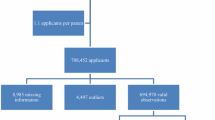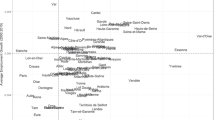Abstract
The limited transferability of knowledge is pivotal to the shaping and defining of the positive effects on total factor productivity of the limited appropriability of knowledge. Access to and use of knowledge spillovers entail relevant absorption costs and exhibit substantial variance across firms, regions, industries, and countries and thus, have a significant influence on actual knowledge cost levels. The analysis in this paper overcomes the limits of current growth theory and highlights the significant variance in levels of pecuniary knowledge externalities which has strong implications for total factor productivity growth. The benefits of knowledge spillovers become evident only if we account for the absorption costs related to the limited transferability of knowledge. A reduction in these costs translates into greater total factor productivity increases. Building on the hypothesis that European integration has led to a reduction in appropriability levels while simultaneously favoring knowledge transfer, we test whether the associated decline in knowledge costs has had a direct effect on levels and growth of total factor productivity. The empirical analysis uses panel ordinary least squares and an original instrumental variables strategy and is applied to a sample of 12 large European countries and 20 industries over the years 1997 through 2018. It confirms that lower costs and faster reductions in the costs of knowledge result in higher levels and higher rates of growth of total factor productivity.


Similar content being viewed by others
Notes
The EPO is the regional patenting institution for the countries in our sample and is responsible for the granting of patents to European Union member states and has a standardized procedure for consideration of patent applications and grants. However, note that the validation and enforcement of patents rely in part on the legal jurisdiction in the countries concerned. Consequently, there may be some disparities in terms of intellectual property protection among our selected countries. However, our analysis focuses solely on patent applications filed at the EPO which allows us to assume that in relation to patenting procedures and incentives, the countries in our sample have similar intellectual property rights regimes.
The countries included in our sample are: Austria (AT), Belgium (BE), Czechia (CZ), Germany (DE), Denmark (DK), Spain (ES), Finland (FI), France (FR), Italy (IT), Netherland (NL), Sweden (SE), United Kingdom (UK).
The ideal specification would entail sectoral disaggregation analysis similar to the second step in our empirical analysis. However, long time-series data on TFP at the country and sectoral levels are available only in terms of growth which forced us to conduct preliminary testing of the relationship between knowledge costs and TFP levels in aggregate terms. However, our main objective is to analyze whether and to what extent the documented decreasing dynamics related to the cost of knowledge in European countries is associated with faster TFP growth rates. We leave in-depth analysis of knowledge costs as a determinant of TFP levels at the industry level to future research.
For the countries in our sample, data on yearly TFP levels, GDP, population, and the share of import and exports were collected from the Penn World Table 10.01 database (Feenstra et al., 2015). GDP per capita is calculated by dividing GDP, expressed in PPP million US dollars at current prices, by population, expressed in million persons. The share of imports employed to measure TO is expressed in negative terms.
It is worth noting that the interpretation of the coefficients for the TFP growth at the frontier and the technology gap should be taken cautiously. Indeed, for the country-industry observations in which the country is leader in the given industry the frontier growth is identical to the dependent variable and the technology gap equals zero, by construction. This may raise possible measurement error concerns related to the estimated level of the two coefficients (Griffith et al., 2004; McMorrow et al., 2010), though we are not primarily interested into the identification of frontier and technology gap specific effects of productivity growth. Yet, in order to alleviate this potential bias, in assessing, yearly, the frontier country by industry in terms of TFP growth rate we exploit the full sample of countries provided in the EU KLEMS database, thus reducing the number of occurrences in which observation i,c,t and the frontier coincide.
Endogeneity issues are alleviated further by the inclusion of non-contemporaneous shift and shares.
To avoid multiple filings and thus double counting of patents across patent offices, we exploit patent families information and restrict the world sample to the first patents in each DOCDB family.
The estimated coefficients for explanatory non-endogenous variables, while included in the first-stage estimation, have been omitted.
References
Antonelli, C. (2013). Knowledge governance, pecuniary knowledge externalities and total factor productivity growth. Economic Development Quarterly, 27(1), 62–70.
Antonelli, C. (2019). The knowledge growth regime: A Schumpeterian approach. Palgrave MacMillan.
Antonelli, C. (2022). The limited transferability of knowledge. In D. Audretsch, A. Link, & E. Lehman (Eds.), Handbook of technology transfer (pp. 11–24). Edward Elgar.
Antonelli, C., & Fusillo, F. (2023). Are ideas getting cheaper? The European evidence. Industrial and Corporate Change, 32(4), 901–929.
Antonelli, C., & Gehringer, A. (2016). The cost of knowledge and productivity growth. In A. N. Link & C. Antonelli (Eds.), Strategic alliances leveraging economic growth and development (pp. 155–174). Routledge.
Archibugi, D. (1992). Patenting as an indicator of technological innovation: A review. Science and Public Policy, 19(6), 357–368.
Archibugi, D. (2001). The globalisation of technology and the European innovation system. In M. M. Fischer & J. Fröhlich (Eds.), Knowledge, complexity and innovation systems. Advances in spatial science (pp. 58–75). Springer.
Arrow, K. J. (1962). Economic welfare and the allocation of resources for invention. In R. R. Nelson (Ed.), The rate and direction of inventive activity: Economic and social factors (pp. 609–625). Princeton University Press for N.B.E.R.
Audretsch, D. B. (2005). The knowledge spillover theory of entrepreneurship and economic growth. In G. T. Vinig & R. C. W. Van Der Voort (Eds.), The emergence of entrepreneurial economics (Vol. 9, pp. 37–54). Emerald Group Publishing Limited.
Audretsch, D. B., & Belitski, M. (2013). The missing pillar: The creativity theory of knowledge spillover entrepreneurship. Small Business Econonomics, 41(4), 819–836.
Audretsch, D. B., Lehman, E. E., Link, A. N., & Starnecker, A. (2012). Technology transfer in a global economy. Springer.
Audretsch, D., Link, A., & Lehman, E. (2022). Handbook of technology transfer (pp. 11–24). Edward Elgar.
Bontadini, F., Corrado, C., Haskel, J., Iommi, M., & Jona-Lasinio, C. (2021). Euklems & intanprod: methods and data descriptions. EU KLEMS website.
Cohen, W. M., & Levinthal, D. A. (1989). Innovation and learning: The two faces of R&D. Economic Journal, 99(397), 569–596.
Cohen, W. M., & Levinthal, D. A. (1990). Absorptive capacity: A new perspective on learning and innovation. Administrative Science Quarterly, 35(1), 128–152.
Conway, P., Nicoletti, G. (2006). Product market regulation in the non-manufacturing sectors of OECD countries: measurement and highlights. OECD Economics Department Working Paper, No.530
Cowan, R., David, P. A., & Foray, D. (2000). The explicit economics of knowledge codification and tacitness. Industrial and Corporate Change, 9(2), 211–253.
David, P.A. (1993). Knowledge, property and the system dynamics of technological change. In: Summers, L.S., Shah, S. (eds.), Proceedings of the World Bank annual conference on development economics (Published as a supplement to the World Bank Economic Review) (pp. 215–248). International Bank for Reconstruction and Development, Washington D.C.
de Rassenfosse, G., & Jaffe, A. B. (2018). Econometric evidence on the depreciation of innovations. European Economic Review, 101, 625–642.
Feenstra, R. C., Inklaar, R., & Timmer, M. P. (2015). The next generation of the Penn World Table. American Economic Review, 105(10), 3150–3182.
Griffith, R., Redding, S., & Reenen, J. V. (2004). Mapping the two faces of R&D: Productivity growth in a panel of OECD industries. Review of Economics and Statistics, 86(4), 883–895.
Griliches, Z. (1979). Issues in assessing the contribution of research and development to productivity growth. Bell Journal of Economics, 10(1), 92–116.
Griliches, Z. (1990). Patent statistics as economic indicators: A survey. Journal of Economic Literature, 28(4), 1661–1707.
Griliches, Z. (1992). The search for R&D spillovers. Scandinavian Journal of Economics, 94(Supplement), 29–47.
Gumpert, A. (2018). The organization of knowledge in multinational firms. Journal of the European Economic Association, 16(6), 1929–1976.
Hall, B., Mairesse, J., Mohnen, P. (2010). Measuring the returns to R&D. In Handbook of the Economics of Innovation (Vol. 2, pp. 1033–1082). North-Holland, Amsterdam.
Jaffe, A. B. (1986). Technological opportunity and spillovers of R&D: Evidence from firms’ patents, profits, and market value. American Economic Review, 76(5), 984–1001.
Jones, C.I. (2021), The past and future of economic growth: A semi-endogenous perspective. NBER working paper 29126. https://doi.org/10.3386/w29126.
Kleibergen, F., & Paap, R. (2006). Generalized reduced rank tests using the singular value decomposition. Journal of Econometrics, 133(1), 97–126.
Lach, S., & Schankerman, M. (1989). Dynamics of R&D and investment in the scientific sector. Journal of Political Economy, 97(4), 880–904.
Link, A. N. (2024). Public sector technology transfer. Edward Elgar.
Link, A. N., & Siegel, D. S. (2007). Innovation entrerpreneurship and technological change. Oxford University Press.
Lybbert, T. J., & Zolas, N. J. (2014). Getting patents and economic data to speak to each other: An ‘algorithmic links with probabilities’ approach for joint analyses of patenting and economic activity. Research Policy, 43(3), 530–542.
Mansfield, E., Schwartz, M., & Wagner, S. (1981). Imitation costs and patents: An empirical study. The Economic Journal, 91(364), 907–918.
Mc Morrow, K., Röger, W., & Turrini, A. (2010). Determinants of TFP growth: A close look at industries driving the EU–US TFP gap. Structural Change and Economic Dynamics, 21(3), 165–180.
Mohnen, P., & Hall, B. (2013). Innovation and productivity: An update. Eurasian Business Review, 3(1), 47–65.
Nicoletti, G., & Scarpetta, S. (2003). Regulation, productivity and growth: OECD evidence. Economic Policy, 18(36), 9–72.
O’Mahony, M., & Timmer, M. P. (2009). Output, input and productivity measures at the industry level: The EU KLEMS database. The Economic Journal, 119(538), F374–F403.
OECD (2022). REGPAT database, August 2022.
Romer, P. M. (1990). Endogenous technological change. Journal of Political Economy, 98, S71–S102.
Romer, P. M. (1994). The origins of endogenous growth. Journal of Economic Perspectives, 8(1), 3–22.
Scitovsky, T. (1954). Two concepts of external economies. Journal of Political Economy, 62(2), 143–151.
Stock, J. H., Yogo, M., (2002). Testing for weak instruments in linear IV regression. NBER Technical Working Papers 0284. National Bureau of Economic Research.
Vandenbussche, J., Aghion, P., & Meghir, C. (2006). Growth, distance to frontier and composition of human capital. Journal of Economic Growth, 11, 97–127.
Funding
This work was supported by Ministero dell’Istruzione, dell’Università e della Ricerca, PRIN research project (Grant No. 20177J2LS9).
Author information
Authors and Affiliations
Corresponding author
Additional information
Publisher's Note
Springer Nature remains neutral with regard to jurisdictional claims in published maps and institutional affiliations.
Rights and permissions
Springer Nature or its licensor (e.g. a society or other partner) holds exclusive rights to this article under a publishing agreement with the author(s) or other rightsholder(s); author self-archiving of the accepted manuscript version of this article is solely governed by the terms of such publishing agreement and applicable law.
About this article
Cite this article
Antonelli, C., Fusillo, F. The limited transferability of knowledge, patent costs and total factor productivity: European evidence. J Technol Transf (2023). https://doi.org/10.1007/s10961-023-10057-3
Accepted:
Published:
DOI: https://doi.org/10.1007/s10961-023-10057-3
Keywords
- Limited knowledge transferability
- Knowledge spillover
- Absorption costs
- Knowledge transfer
- Patent costs
- Total factor productivity




